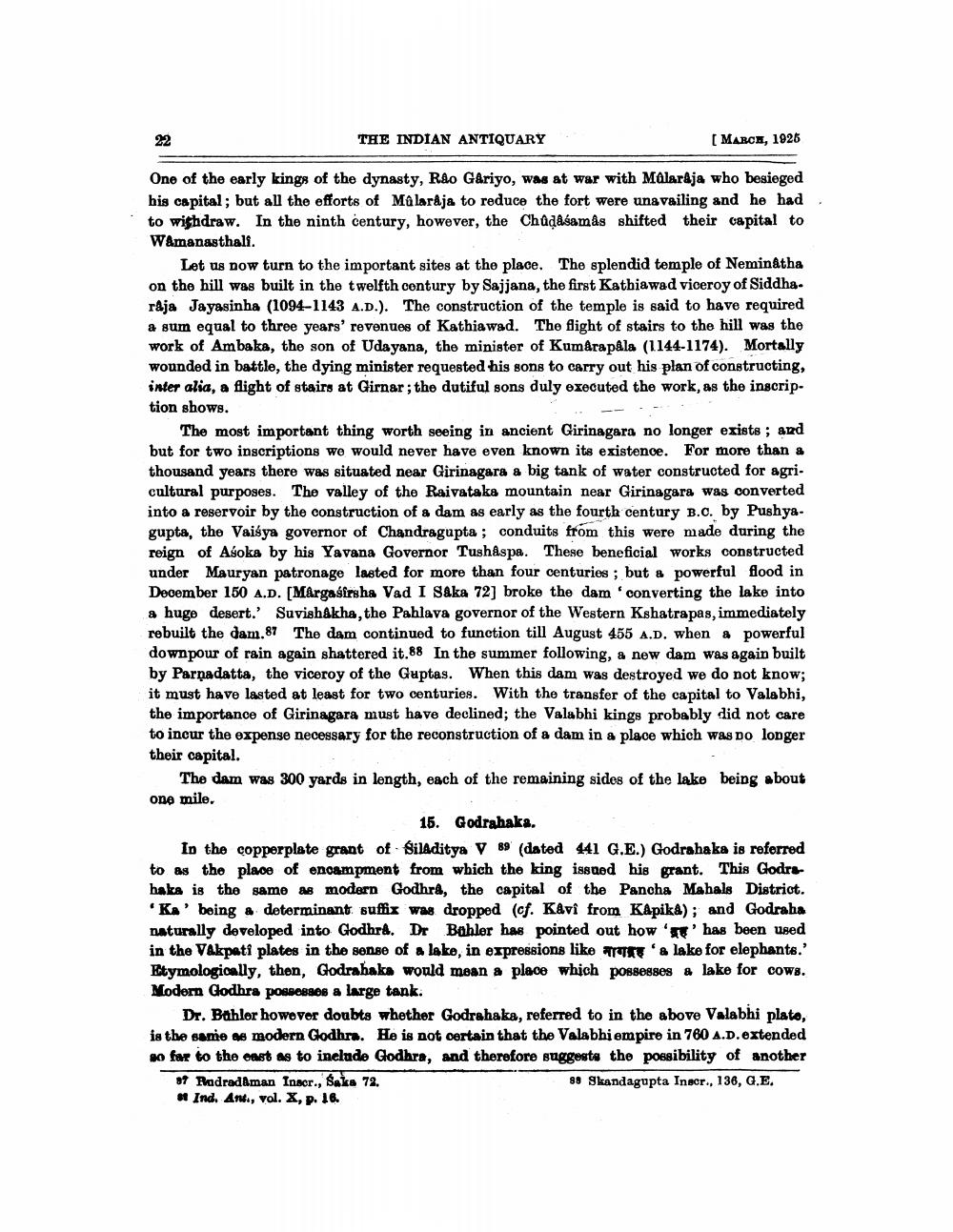________________
22
THE INDIAN ANTIQUARY
[MARCH, 1925
One of the early kings of the dynasty, Rao Gâriyo, was at war with Malaraja who besieged his capital; but all the efforts of Mûlaraja to reduce the fort were unavailing and he had to withdraw. In the ninth century, however, the Chuḍaśamâs shifted their capital to Wamanasthali.
Let us now turn to the important sites at the place. The splendid temple of Neminatha on the hill was built in the twelfth century by Sajjana, the first Kathiawad viceroy of Siddha. raja Jayasinha (1094-1143 A.D.). The construction of the temple is said to have required a sum equal to three years' revenues of Kathiawad. The flight of stairs to the hill was the work of Ambaka, the son of Udayana, the minister of Kumarapala (1144-1174). Mortally wounded in battle, the dying minister requested his sons to carry out his plan of constructing, inter alia, a flight of stairs at Girnar; the dutiful sons duly executed the work, as the inscription shows.
The most important thing worth seeing in ancient Girinagara no longer exists; and but for two inscriptions we would never have even known its existence. For more than a thousand years there was situated near Girinagara a big tank of water constructed for agricultural purposes. The valley of the Raivataka mountain near Girinagara was converted into a reservoir by the construction of a dam as early as the fourth century B.C. by Pushyagupta, the Vaisya governor of Chandragupta; conduits from this were made during the reign of Asoka by his Yavana Governor Tushâspa. These beneficial works constructed under Mauryan patronage lasted for more than four centuries; but a powerful flood in December 150 A.D. [Margasirsha Vad I Saka 72] broke the dam 'converting the lake into a huge desert.' Suvishakha, the Pahlava governor of the Western Kshatrapas, immediately rebuilt the dam.87 The dam continued to function till August 455 A.D. when a powerful downpour of rain again shattered it.88 In the summer following, a new dam was again built by Parnadatta, the viceroy of the Guptas. When this dam was destroyed we do not know; it must have lasted at least for two centuries. With the transfer of the capital to Valabhi, the importance of Girinagara must have declined; the Valabhi kings probably did not care to incur the expense necessary for the reconstruction of a dam in a place which was no longer their capital.
The dam was 300 yards in length, each of the remaining sides of the lake being about one mile.
15. Godrahaka.
In the copperplate grant of Siladitya V 89 (dated 441 G.E.) Godrahaka is referred to as the place of encampment from which the king issued his grant. This Godrahaka is the same as modern Godhra, the capital of the Pancha Mahals District. 'Ka' being a determinant suffix was dropped (cf. Kavi from Kapika); and Godraha naturally developed into Godhra. Dr Bühler has pointed out how '' has been used in the Vakpati plates in the sense of a lake, in expressions like a lake for elephants.' Etymologically, then, Godrahaks would mean a place which possesses a lake for cows. Modern Godhra possesses a large tank.
C
Dr. Bühler however doubts whether Godrahaka, referred to in the above Valabhi plate, is the same as modern Godhra. He is not certain that the Valabhi empire in 760 A.D. extended so far to the east as to include Godhra, and therefore suggests the possibility of another
88 Skandagupta Inscr., 136, G.E.
87 Rudrad&man Inscr., Saka 72. st Ind. Ant., vol. X, p. 16.




